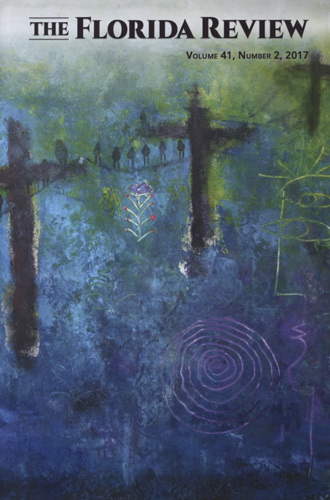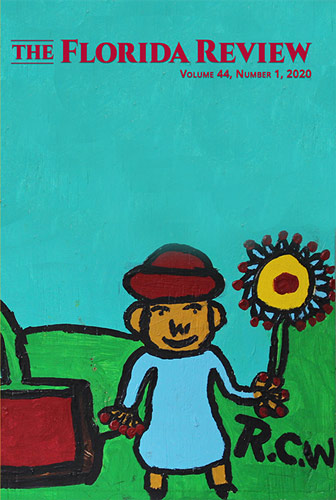Before I get into discussion of interesting pieces, I want to stop for a moment and draw attention to The Florida Review’s commitment to the education of budding artists. In the Fall 2017 issue, The Florida Review gives a generous note about editorial interns, both graduate and undergraduate, who are “involved in reviewing and discussing submissions in a way that helps the senior editorial staff stay sharp and articulate [their] own reasons for [their] choices.” In addition, on the journal’s website, they outline their educational mission which helps interns to “thrive as writers and to appreciate the intense and collaborative nature of publications.” As a recent graduate, I greatly appreciate and support The Florida Review’s commitment to education which contributes to the literary world.
Before I get into discussion of interesting pieces, I want to stop for a moment and draw attention to The Florida Review’s commitment to the education of budding artists. In the Fall 2017 issue, The Florida Review gives a generous note about editorial interns, both graduate and undergraduate, who are “involved in reviewing and discussing submissions in a way that helps the senior editorial staff stay sharp and articulate [their] own reasons for [their] choices.” In addition, on the journal’s website, they outline their educational mission which helps interns to “thrive as writers and to appreciate the intense and collaborative nature of publications.” As a recent graduate, I greatly appreciate and support The Florida Review’s commitment to education which contributes to the literary world.
Another feature that distinguishes this issue of The Florida Review is a Special Section on Prison; it contains pieces written by prisoners and their loved ones. The editor, Lisa Roney, notes that the issue’s special section is “the yin of victimhood to the yang of punishment” of the previous, 41.1 issue. Challenging their readers, this section offers Ana Castillo’s excerpts from her book Black Dove and various, challenging poems exploring “echoes about prison.”
Ana Castillo’s excerpts from “Mi’jo’s Canon in D Major” offer a startling point of departure for this section. Written from the first person, this piece places its readers into shoes of a brilliant woman, a mother, who senses that something is wrong with her son:
In Italy, at San Antonio’s Basilica, I lit candles for him at the foot of the sarcophagus of the saint. I anguished the way old-world mothers anguish over their grown sons. I’d seen him through college. He was still my child, my flesh and blood. With no replies to my calls or emails I maintained an outer composure, especially during my public commitments, but inside I was a wreck, worse with each passing day of silence.
She not only offers an account of what has happened to her son, his arrest and incarceration, but also explores results of the historical trauma that left psychological and emotional wounds.
Not surprisingly, this issue of The Florida Review offers other literary gems in its treasure chest besides the Special Section on Prison. Erin Adair-Hodges’s poem “The Mammogram” catches readers’ eyes with its striking frankness. As the technician performing the mammogram, Adair-Hodges’s speaker reflects on her girlhood and delayed maturing into a woman:
I had been a girl for so long.
In gym I craved the secret hairand whispered need
of a welcome gift for Aunt Flo,cigar for Uncle Red,
Clucked jive of our tribe.I even once asked
a semi-popular girl to passme a pad, to smuggle
it to me in math. For what?she laughed,
Arts and crafts?
The poem explores the speaker’s journey into womanhood and her pregnancy. Reading this poem, I thought of Walt Whitman’s “I Sing the Body Electric” and its celebration of human body. While Erin Adair-Hodges’s “The Mammogram” also explores wonderful capabilities of a woman’s body, it does so with a melancholic tinge.
“What remains after death?” asks Kelly Martineau in her nonfiction essay “Body of Water.” Getting ready to release her father-in-law Jim’s ashes into Pacific Ocean, Martineau walks her readers through the journey of meeting and getting to know Jim. Notably, this essay has sections that explore the Ayurvedic system of healing, quilting, and her own reflections about Jim. Beautifully interlaced, these sections come together in a quilt of an essay that both stimulates imagination and challenges its readers.
Daphne Kalotay’s fiction piece “Relativity” is yet another remarkable gem in the Fall 2017 issue of The Florida Review. Written in third-person, the story centers around Robert, who offers senior services to Holocaust survivors. Sometimes Robert’s clients “fell into reminiscence at a mere turn of phrase. So many stories! Robert filed them away in his mind like grizzly fairy tales.” Robert establishes a connection with one of his clients, Rozsa Fischer, a tough lady who continues to endure despite doctor’s prognosis. Frank and moving, this piece reveals Robert’s own tragedy. “Relativity” is worth reading twice to catch almost intangible details that are masterfully integrated in the text.
In addition to prose and poetry, the Fall 2017 issue offers two graphic narratives: “A Celestial Life” by Steve Ward and “How to Listen” by Jennifer Murvin, both of which stimulate readers’ imaginations. As a seeker of hidden gems, this issue of The Florida Review has pleasantly surprised me with the richness and variety of its prose, poetry, and graphic narratives. Plus, it is always good to support a magazine that contributes to the education of young minds.
[floridareview.cah.ucf.edu]




